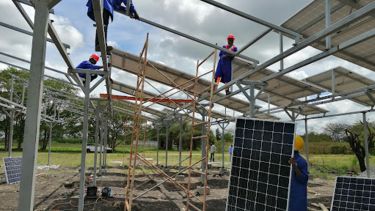Harvesting the sun twice: enhancing livelihoods in East African agricultural communities through innovations in solar energy
A project by Richard Randle-Boggis

Food and energy insecurity are two of East Africa’s greatest challenges. Two thirds of the region’s population lack access to electricity, and crop yields are predicted to decrease by 8-45% by 2050 due to climate change. Electrification through conventional ground-mounted solar panels occupies land that could be used to grow food, so clean energy technologies that do not conflict with agriculture are needed.
Our project, “Harvesting the sun twice: enhancing livelihoods in East African agricultural communities through innovations in solar energy”, determines the livelihood benefits of agrivoltaics -solar panels raised above cropland. The panels provide electricity to farmers and communities, while the partial shading creates a favourable growing environment by reducing water loss and heat stress, thus enhancing yields, reducing drought impacts, and allowing the cultivation of higher value and more nutritious crops such as beans and other vegetables.
We are engaging with local communities, regional organisations and national stakeholders to better understand their perspective of this technology and the drivers and barriers associated with its uptake. We are testing the performance of two pilot systems in Kenya and Tanzania and collating information for community leaders, agribusinesses and policy makers to support and optimise uptake of agrivoltaics across East Africa.
